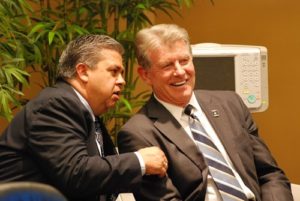Connecting “Autonomy,” “Accountability,” & the Common Core National Standards
Here’s how things are going in Idaho. Quick history: In 2011, three laws similar to others in the nation —bust collective bargaining, put in pay-for-performance, and roll out the lap-tops and online “learning” — were passed by lawmakers despite visible and audible protests from Idahoans. But the People in Idaho didn’t roll over. They came back to put them (the Luna Laws) on the ballot in 2012 and defeated all three proposals – SOUNDLY!!! But quietly the foxes have entered the hen house and are going in for the kill. They are doing it through a governor-selected “task force.”
Moving Beyond the Killer B’s: The Role of School Boards in School Accountability and Transformation bases its recommendations on the idea that it is important “to ensure that their [school board] policies and practices align with the pressing need to ensure that all students are provided a high-quality education, enabling them to succeed in college and post-graduation careers.” They express that “the Common Core State Standards [are] aimed at ensuring that all states strive to teach a high level curriculum and administer rigorous assessments.”(page 4) It was expressed that originally Race to the Top had included formal school board evaluations (page 5).
And so it appears that “they” thought of every aspect of The Common Core System.
The Killer B’s document describes a scheme that in essence promotes the idea of using federal funds to accomplish a wide array of tasks including the establishment of “technical assistance centers” called “Regional Comprehensive Centers” (RCCs) (page ii, 24).
Moving Beyond the Killer B’s (copyrighted by the Academic Development Institute (ADI)) can be found on The Center for School Turnarounds primarily sponsored by WestEd along with ADI.
WestEd (nonpartisan, nonprofit) regional centers are established in California, Mid-Atlantic, West, Southwest, Central, Northeast, South Central, Great Lakes, Midwest, Pacific, Appalachia, and Texas. And there could be more WestEd Regional Comprehensive Centers that I missed.
WestEd is the Project Management Partner for the Smarter Balanced Assessment Consortium (our Common Core Tests).
Following the lead of Idaho’s State Chief Deputy Superintendent, Rodger Quarles, who was a contributor to the Killer B’s document and a member of the Governor’s Task Force on Improving Education, the Training & Development of School Boards is now on the legislative table (Effective Teachers & Leaders Recommendation #2.5, Task Force doc., Page 37).
And here is where “autonomy” comes into question: Idaho Structural Change Subcommittee’s Strategy 2: Autonomy and Accountability
“…the State should set goals for the public education system, allocate monies, and then hold local leadership accountable for progress against those goals.” (Page 19 Task Force)
When the Common Core National Standards sets the standards, aligns the tests, aligns the curriculum, and, on the advice of the Chief Council of State school Officers (CCSSO) and National Governor’s Association (NGA), aligns the training of teachers, superintendents, and principals, plus the National Parent Teachers Association did their best to train parents to accept Common Core — the only thing left is to train and align the school board members with the help of the School Board Associations and the same non-governmental, non-accountable group that will be “partnering” in the tests —WestEd. Plus, organizations like the Broad Foundation have years of experience training leaders.
With test-driven reforms (they call “outcome-based”), He who controls the tests controls what is learned — especially if all the pieces of the machine are in alignment. Is this the systemic change we want?

Is the American education system to become just one cog in the machine?
“Autonomy”? The Task Force defines it as “people’s need to be empowered to take ownership for results and to have the flexibility to address challenges and local dynamics they face in pursuit of results for our students.” It is not defined here as self-governing and definitely NOT the same as “local control.”
There is nothing of educational significance left to control – goals, standards, tests, training for instruction, curriculum, and governance are all decided and out of our control. All that is left is the hard work of ensuring learning, in some form, occurs – In it, we will have no voice that will be heard by the large conglomerates that will control our schools. Proof ? Do they hear us asking them right now to STOP the CORE? Put the testing on pause. They do in some states but what of the nation?
And those that attended the No Child Left Behind workshop by Gary Ratner and myself at the Save Our Schools conference in D.C. in 2012 heard me ask this question, do we want organizations like the Broad Foundation training our school leaders or do we want it done through public institutions?
The education “reform” laws that Idahoans defeated looked to me to be “models” for the nation. So what is happening now with leadership training in the rest of the nation?












